Waseem Akram
Maritime Mission Planning for Unmanned Surface Vessel using Large Language Model
Mar 15, 2025Abstract:Unmanned Surface Vessels (USVs) are essential for various maritime operations. USV mission planning approach offers autonomous solutions for monitoring, surveillance, and logistics. Existing approaches, which are based on static methods, struggle to adapt to dynamic environments, leading to suboptimal performance, higher costs, and increased risk of failure. This paper introduces a novel mission planning framework that uses Large Language Models (LLMs), such as GPT-4, to address these challenges. LLMs are proficient at understanding natural language commands, executing symbolic reasoning, and flexibly adjusting to changing situations. Our approach integrates LLMs into maritime mission planning to bridge the gap between high-level human instructions and executable plans, allowing real-time adaptation to environmental changes and unforeseen obstacles. In addition, feedback from low-level controllers is utilized to refine symbolic mission plans, ensuring robustness and adaptability. This framework improves the robustness and effectiveness of USV operations by integrating the power of symbolic planning with the reasoning abilities of LLMs. In addition, it simplifies the mission specification, allowing operators to focus on high-level objectives without requiring complex programming. The simulation results validate the proposed approach, demonstrating its ability to optimize mission execution while seamlessly adapting to dynamic maritime conditions.
Ontology-driven Prompt Tuning for LLM-based Task and Motion Planning
Dec 10, 2024Abstract:Performing complex manipulation tasks in dynamic environments requires efficient Task and Motion Planning (TAMP) approaches, which combine high-level symbolic plan with low-level motion planning. Advances in Large Language Models (LLMs), such as GPT-4, are transforming task planning by offering natural language as an intuitive and flexible way to describe tasks, generate symbolic plans, and reason. However, the effectiveness of LLM-based TAMP approaches is limited due to static and template-based prompting, which struggles in adapting to dynamic environments and complex task contexts. To address these limitations, this work proposes a novel ontology-driven prompt-tuning framework that employs knowledge-based reasoning to refine and expand user prompts with task contextual reasoning and knowledge-based environment state descriptions. Integrating domain-specific knowledge into the prompt ensures semantically accurate and context-aware task plans. The proposed framework demonstrates its effectiveness by resolving semantic errors in symbolic plan generation, such as maintaining logical temporal goal ordering in scenarios involving hierarchical object placement. The proposed framework is validated through both simulation and real-world scenarios, demonstrating significant improvements over the baseline approach in terms of adaptability to dynamic environments, and the generation of semantically correct task plans.
Benchmarking Vision-Based Object Tracking for USVs in Complex Maritime Environments
Dec 10, 2024Abstract:Vision-based target tracking is crucial for unmanned surface vehicles (USVs) to perform tasks such as inspection, monitoring, and surveillance. However, real-time tracking in complex maritime environments is challenging due to dynamic camera movement, low visibility, and scale variation. Typically, object detection methods combined with filtering techniques are commonly used for tracking, but they often lack robustness, particularly in the presence of camera motion and missed detections. Although advanced tracking methods have been proposed recently, their application in maritime scenarios is limited. To address this gap, this study proposes a vision-guided object-tracking framework for USVs, integrating state-of-the-art tracking algorithms with low-level control systems to enable precise tracking in dynamic maritime environments. We benchmarked the performance of seven distinct trackers, developed using advanced deep learning techniques such as Siamese Networks and Transformers, by evaluating them on both simulated and real-world maritime datasets. In addition, we evaluated the robustness of various control algorithms in conjunction with these tracking systems. The proposed framework was validated through simulations and real-world sea experiments, demonstrating its effectiveness in handling dynamic maritime conditions. The results show that SeqTrack, a Transformer-based tracker, performed best in adverse conditions, such as dust storms. Among the control algorithms evaluated, the linear quadratic regulator controller (LQR) demonstrated the most robust and smooth control, allowing for stable tracking of the USV.
Long-Range Vision-Based UAV-assisted Localization for Unmanned Surface Vehicles
Aug 21, 2024Abstract:The global positioning system (GPS) has become an indispensable navigation method for field operations with unmanned surface vehicles (USVs) in marine environments. However, GPS may not always be available outdoors because it is vulnerable to natural interference and malicious jamming attacks. Thus, an alternative navigation system is required when the use of GPS is restricted or prohibited. To this end, we present a novel method that utilizes an Unmanned Aerial Vehicle (UAV) to assist in localizing USVs in GNSS-restricted marine environments. In our approach, the UAV flies along the shoreline at a consistent altitude, continuously tracking and detecting the USV using a deep learning-based approach on camera images. Subsequently, triangulation techniques are applied to estimate the USV's position relative to the UAV, utilizing geometric information and datalink range from the UAV. We propose adjusting the UAV's camera angle based on the pixel error between the USV and the image center throughout the localization process to enhance accuracy. Additionally, visual measurements are integrated into an Extended Kalman Filter (EKF) for robust state estimation. To validate our proposed method, we utilize a USV equipped with onboard sensors and a UAV equipped with a camera. A heterogeneous robotic interface is established to facilitate communication between the USV and UAV. We demonstrate the efficacy of our approach through a series of experiments conducted during the ``Muhammad Bin Zayed International Robotic Challenge (MBZIRC-2024)'' in real marine environments, incorporating noisy measurements and ocean disturbances. The successful outcomes indicate the potential of our method to complement GPS for USV navigation.
MuLA-GAN: Multi-Level Attention GAN for Enhanced Underwater Visibility
Dec 25, 2023Abstract:The underwater environment presents unique challenges, including color distortions, reduced contrast, and blurriness, hindering accurate analysis. In this work, we introduce MuLA-GAN, a novel approach that leverages the synergistic power of Generative Adversarial Networks (GANs) and Multi-Level Attention mechanisms for comprehensive underwater image enhancement. The integration of Multi-Level Attention within the GAN architecture significantly enhances the model's capacity to learn discriminative features crucial for precise image restoration. By selectively focusing on relevant spatial and multi-level features, our model excels in capturing and preserving intricate details in underwater imagery, essential for various applications. Extensive qualitative and quantitative analyses on diverse datasets, including UIEB test dataset, UIEB challenge dataset, U45, and UCCS dataset, highlight the superior performance of MuLA-GAN compared to existing state-of-the-art methods. Experimental evaluations on a specialized dataset tailored for bio-fouling and aquaculture applications demonstrate the model's robustness in challenging environmental conditions. On the UIEB test dataset, MuLA-GAN achieves exceptional PSNR (25.59) and SSIM (0.893) scores, surpassing Water-Net, the second-best model, with scores of 24.36 and 0.885, respectively. This work not only addresses a significant research gap in underwater image enhancement but also underscores the pivotal role of Multi-Level Attention in enhancing GANs, providing a novel and comprehensive framework for restoring underwater image quality.
Marine$\mathcal{X}$: Design and Implementation of Unmanned Surface Vessel for Vision Guided Navigation
Nov 28, 2023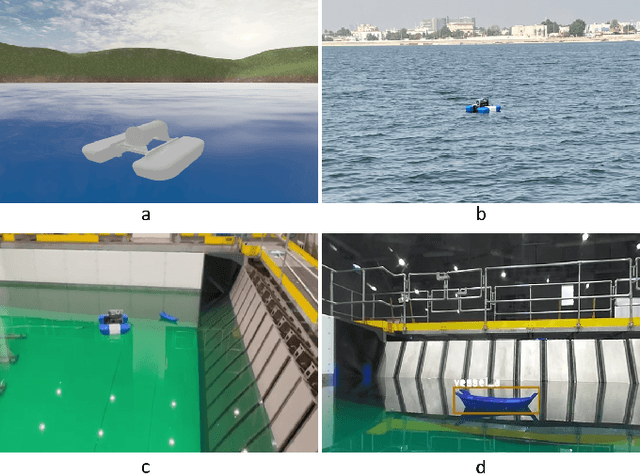
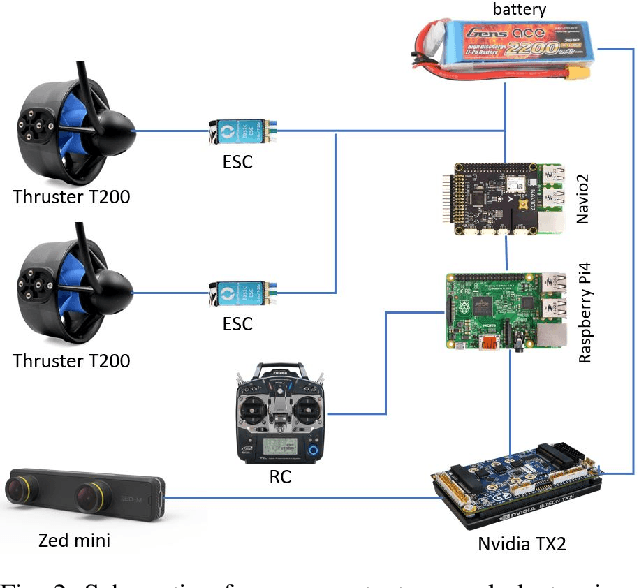
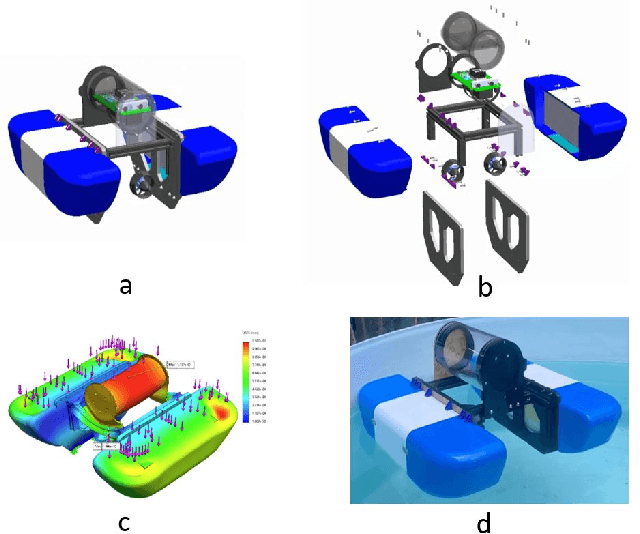
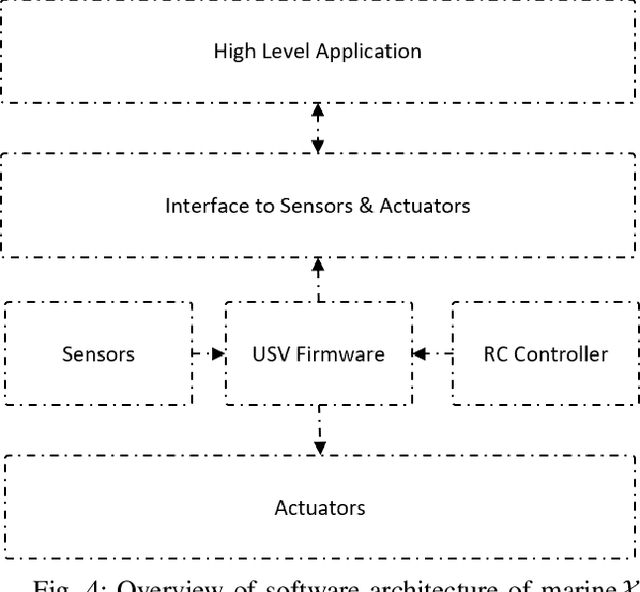
Abstract:Marine robots, particularly Unmanned Surface Vessels (USVs), have gained considerable attention for their diverse applications in maritime tasks, including search and rescue, environmental monitoring, and maritime security. This paper presents the design and implementation of a USV named marine$\mathcal{X}$. The hardware components of marine$\mathcal{X}$ are meticulously developed to ensure robustness, efficiency, and adaptability to varying environmental conditions. Furthermore, the integration of a vision-based object tracking algorithm empowers marine$\mathcal{X}$ to autonomously track and monitor specific objects on the water surface. The control system utilizes PID control, enabling precise navigation of marine$\mathcal{X}$ while maintaining a desired course and distance to the target object. To assess the performance of marine$\mathcal{X}$, comprehensive testing is conducted, encompassing simulation, trials in the marine pool, and real-world tests in the open sea. The successful outcomes of these tests demonstrate the USV's capabilities in achieving real-time object tracking, showcasing its potential for various applications in maritime operations.
* accepted in ICAR
Evaluating Deep Learning Assisted Automated Aquaculture Net Pens Inspection Using ROV
Aug 26, 2023Abstract:In marine aquaculture, inspecting sea cages is an essential activity for managing both the facilities' environmental impact and the quality of the fish development process. Fish escape from fish farms into the open sea due to net damage, which can result in significant financial losses and compromise the nearby marine ecosystem. The traditional inspection system in use relies on visual inspection by expert divers or ROVs, which is not only laborious, time-consuming, and inaccurate but also largely dependent on the level of knowledge of the operator and has a poor degree of verifiability. This article presents a robotic-based automatic net defect detection system for aquaculture net pens oriented to on-ROV processing and real-time detection. The proposed system takes a video stream from an onboard camera of the ROV, employs a deep learning detector, and segments the defective part of the image from the background under different underwater conditions. The system was first tested using a set of collected images for comparison with the state-of-the-art approaches and then using the ROV inspection sequences to evaluate its effectiveness in real-world scenarios. Results show that our approach presents high levels of accuracy even for adverse scenarios and is adequate for real-time processing on embedded platforms.
Autonomous Underwater Robotic System for Aquaculture Applications
Aug 26, 2023Abstract:Aquaculture is a thriving food-producing sector producing over half of the global fish consumption. However, these aquafarms pose significant challenges such as biofouling, vegetation, and holes within their net pens and have a profound effect on the efficiency and sustainability of fish production. Currently, divers and/or remotely operated vehicles are deployed for inspecting and maintaining aquafarms; this approach is expensive and requires highly skilled human operators. This work aims to develop a robotic-based automatic net defect detection system for aquaculture net pens oriented to on- ROV processing and real-time detection of different aqua-net defects such as biofouling, vegetation, net holes, and plastic. The proposed system integrates both deep learning-based methods for aqua-net defect detection and feedback control law for the vehicle movement around the aqua-net to obtain a clear sequence of net images and inspect the status of the net via performing the inspection tasks. This work contributes to the area of aquaculture inspection, marine robotics, and deep learning aiming to reduce cost, improve quality, and ease of operation.
Vision-Based Autonomous Navigation for Unmanned Surface Vessel in Extreme Marine Conditions
Aug 08, 2023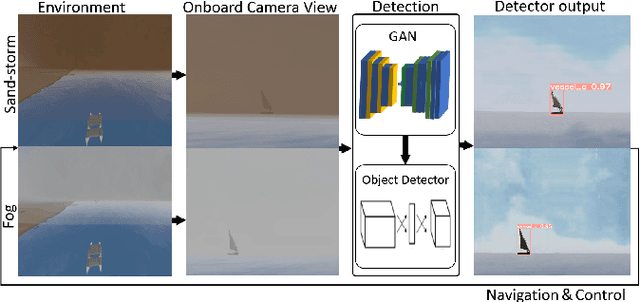
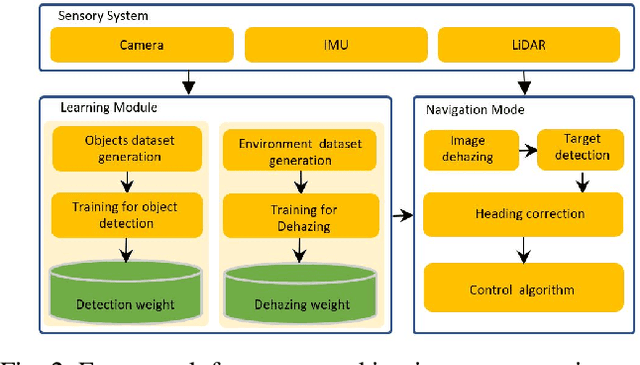
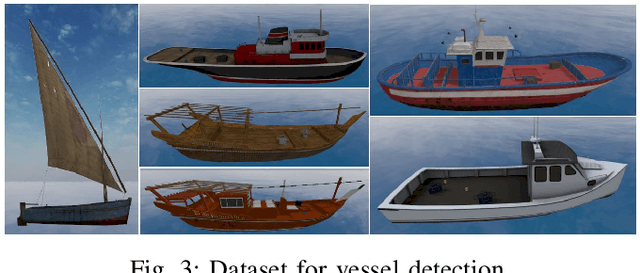
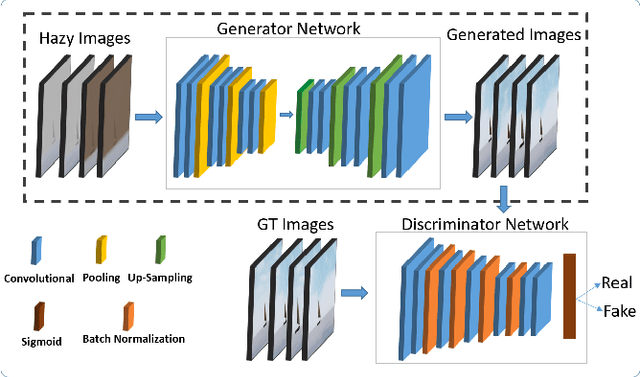
Abstract:Visual perception is an important component for autonomous navigation of unmanned surface vessels (USV), particularly for the tasks related to autonomous inspection and tracking. These tasks involve vision-based navigation techniques to identify the target for navigation. Reduced visibility under extreme weather conditions in marine environments makes it difficult for vision-based approaches to work properly. To overcome these issues, this paper presents an autonomous vision-based navigation framework for tracking target objects in extreme marine conditions. The proposed framework consists of an integrated perception pipeline that uses a generative adversarial network (GAN) to remove noise and highlight the object features before passing them to the object detector (i.e., YOLOv5). The detected visual features are then used by the USV to track the target. The proposed framework has been thoroughly tested in simulation under extremely reduced visibility due to sandstorms and fog. The results are compared with state-of-the-art de-hazing methods across the benchmarked MBZIRC simulation dataset, on which the proposed scheme has outperformed the existing methods across various metrics.
Towards Agent-Based Model Specification in Smart Grid: A Cognitive Agent-based Computing Approach
Nov 18, 2017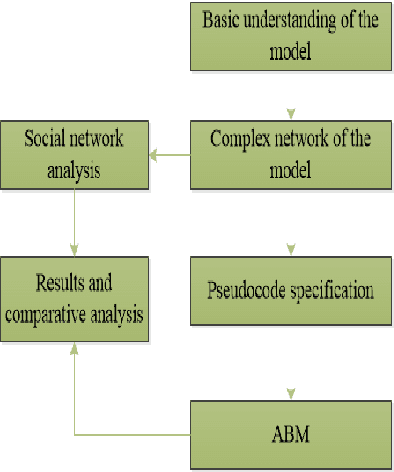
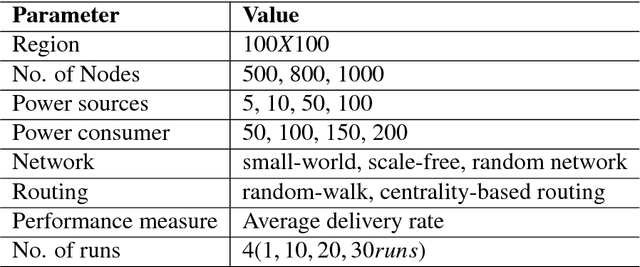
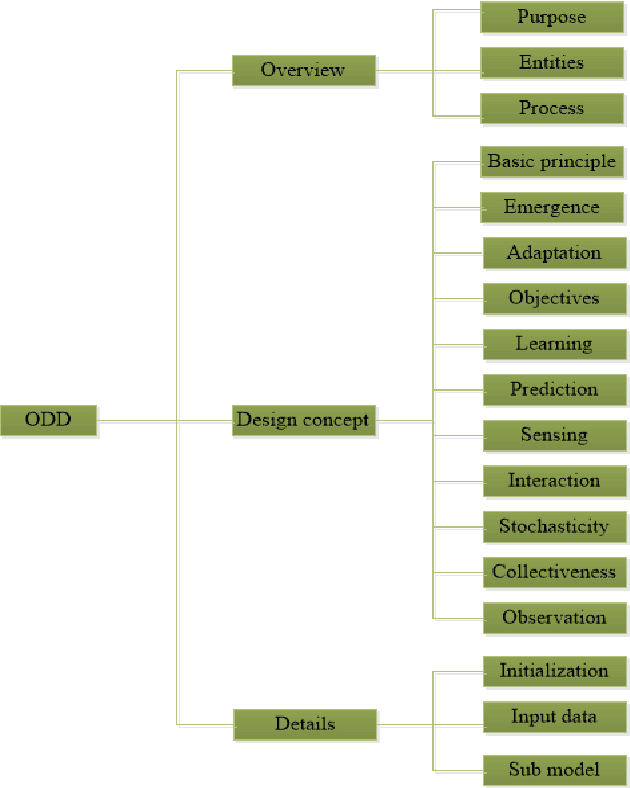

Abstract:A smart grid can be considered as a complex network where each node represents a generation unit or a consumer. Whereas links can be used to represent transmission lines. One way to study complex systems is by using the agent-based modeling (ABM) paradigm. An ABM is a way of representing a complex system of autonomous agents interacting with each other. Previously, a number of studies have been presented in the smart grid domain making use of the ABM paradigm. However, to the best of our knowledge, none of these studies have focused on the specification aspect of ABM. An ABM specification is important not only for understanding but also for replication of the model. In this study, we focus on development as well as specification of ABM for smart grid. We propose an ABM by using a combination of agent-based and complex network-based approaches. For ABM specification, we use ODD and DREAM specification approaches. We analyze these two specification approaches qualitatively as well as quantitatively. Extensive experiments demonstrate that DREAM is a most useful approach as compared with ODD for modeling as well as for replication of models for smart grid.
 Add to Chrome
Add to Chrome Add to Firefox
Add to Firefox Add to Edge
Add to Edge